































MIDWEEK UPDATE 29 SEPTEMBER 2022
Google Banner Ad
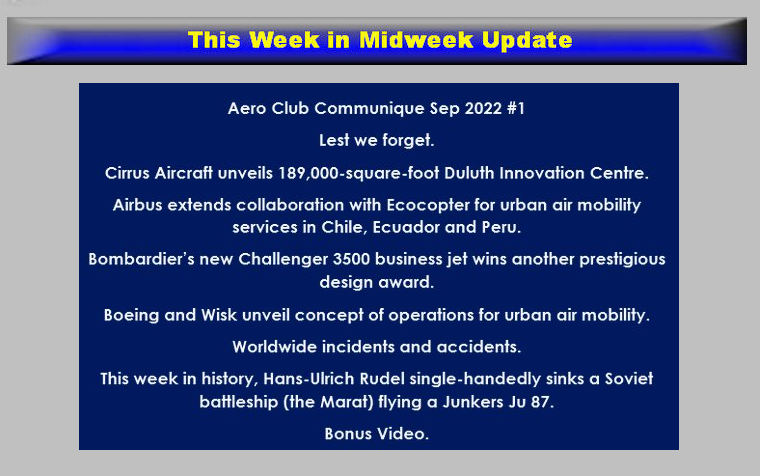

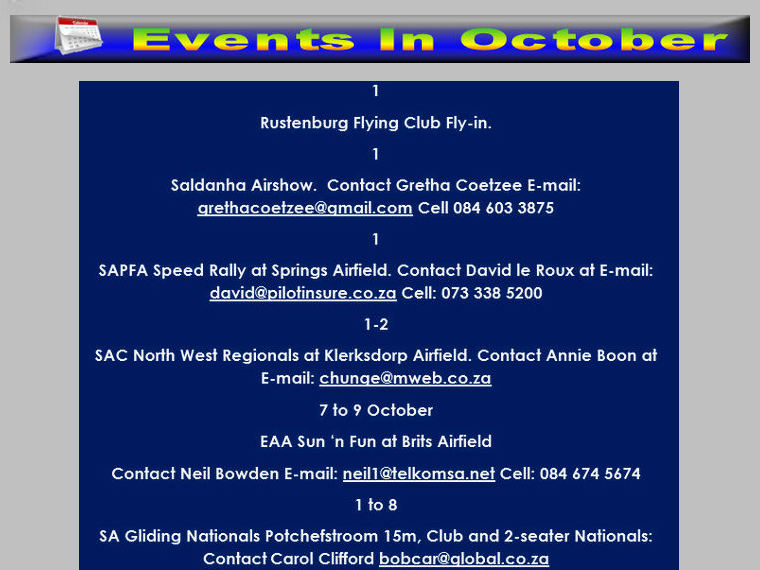
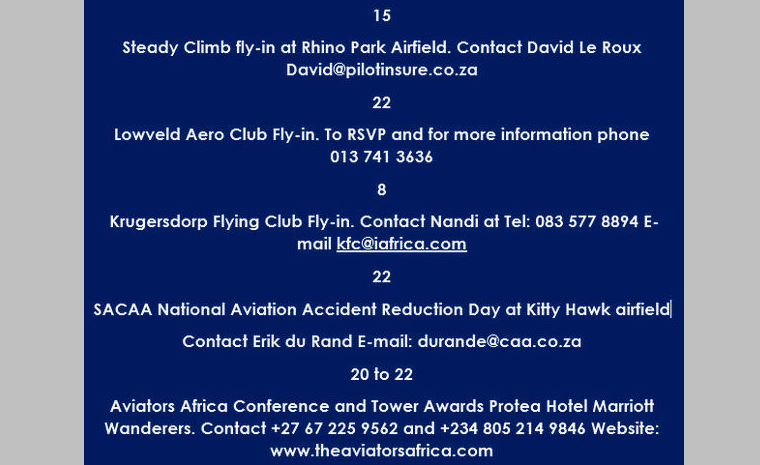




Advocacy Matters
It's been a while since the last communique, where the winter months have brought out many of us to fly in good weather conditions and aviation events have been increasing with some air shows taking place, with AAD also returning after a drought of 4 years. It is unfortunate that the fuel price is dampening our activities to the fullest extent that it could have been, with northern hemisphere economic disruption and inflation possibly also going to affect us in the coming months.
In the interim on advocacy matters, the Aero Club has remained engaged on a number of fronts. The prime topic is still the Part 139 sub part 5 related to the proposed licencing of airfields with certain types of operations. We are part of the discussions to propose a more appropriate regulatory framework that steers away from "licencing" but rather look at definitions that would in essence self-regulate and self-assess such operations, as well as weight classes. It will still take some time, but we will ensure that we are well represented to keep GA/RA operations as unaffected as possible.
National Accident Reduction Week
The CAA has put together an initiative for an accident reduction week as part of their GASS initiative and as such two events will be taking place, one in the WC (Stellenbosch) and the other in GP (Kitty Hawk) on the weekend of 14/15 October and 22 October respectively. See the detail adverts below, all are welcome to attend and take part.
If you are not a member and wish to join the Aero Club and any of its Sections feel free to do so: member-renewals-and-new-memberships
Our Centenary Yearbook is now fully available to purchase (see advert below) from our new web shop www.aeroclub.org.za/shop

LEST WE FORGET
defenceWeb Written by Sam J Basch
Adrian van der Byl receives the original brass grave marker from Major General Mbukeli Songqushwa. The marker is destined once again for the grave of Captain Lawrence van der Byl.
In a poignant ceremony on Sunday this week, the South African Air Force (SAAF) and the SAAF Association paid tribute to all South African air personnel who died in service of their country.
That date, 18 September, marked the centenary of the first fatal military aviation accident in South Africa, which occurred on a farm at Irene outside Pretoria. At the time, the nascent air force was just two years old.
On that day in 1922 the young Captain Albert Lawrence Montagu van der Byl (29) was piloting a South African Air Force two-seater trainer Avro 450K biplane - with tail number H9699 - from his base at Robert's Heights, now called Thaba Tshwane. Lawrence had a passenger, Lieutenant Edward Armstrong Stuart of the 1st SA Mounted Rifles on board and was heading to the family farm at Irene, where he executed an aerobatic sequence. Sadly, witnesses said the aircraft's wing broke, causing the aircraft to crash near the farmhouse.
Both occupants succumbed to their injuries. Despite an extensive investigation, the exact cause of the accident remained undetermined.
Chief Director Air Policies and Plans, Major General Mbukeli Songqushwa, representing the Chief of the Air Force, noted that the then fledgling Air Force was experiencing the very same problem the SAAF is facing today, namely a lack of sufficient funds. “Funding is diminishing every financial year, but the mandate of the Air Force has not changed,” he said.
He noted today's SAAF has to ensure its current generation of fighter aircraft are operating efficiently although without sufficient funding, yet the fighter capability has to be maintained and advanced in the face of technologies that are advancing on a daily basis.
“A fully funded Air Force - and a Department of Defence at large - will lead to a fully functioning and productive defence industry, which we know at present is being challenged,” he stated. “A productive defence industry will lead to technology advancement in the country, which in turn will lead to other countries buying those technology products from South Africa.”
At the time of Captain Lawrence van der Byl, the Air Force was advocating air power, which by itself is not sufficient without space power, according to the general. He said there are resources in space that could negatively affect air power endeavours. (This is a subject covered by a conference at the Africa Aerospace and Defence exhibition this week).
“Space power is defined as 'the total strength of a nation's capabilities to conduct and influence activities to, in, through and from space to achieve its objectives'. Therefore, the Air Force has embarked on a new vision, which is to project effective air and space power through innovation in the theatre of operations,” he explained.
In reference to the Africa Aerospace and Defence show (AAD 2022) taking place at Air Force Base Waterkloof this week, he said visitors to the event want to see aviators in action. At the time of Captain Lawrence van der Byl, there was no such event, but his legacy remains to this day.
“In closing, let us remember the trailblazers in aviation, who dedicated their lives as prominent aviators to duty and to serve their country.”

As current owner of the historic Irene farm where the memorial service was held, Adrian van der Byl spoke on behalf of the Van der Byl family. He thanked the SAAF and SAAF Association for hosting the commemoration, which is also a tribute to all other aviators who served in the country.
For the benefit of his family, he explained that the Avro 450K biplane Captain Lawrence was flying, came into being only 16 years after the Wright Brothers flight in 1903.
“Although this was seen as progress, the Avro was rather primitive: essentially made of wood, canvas and string,” he explained. “The conditions for flying that morning, just after 07:00, were good, as this morning. It is very sad that Captain Lawrence and Lieutenant Stuart died so young.”
He mentioned that his own grandfather Henry van der Byl, then almost the same age as Lawrence, had been invited to fly with his nephew. Fortunately, Henry's wife Evelyn put a stop to it, possibly saving his life. However, Henry's son David went on to also serve in the SAAF.
“Whilst service to country runs in our heritage, and what was always special for my father David, and will doubtless resonate with any air force pilot is to combine the passion of flying with duty,” he concluded.

Adrian van der Byl was ceremoniously handed a brass grave marker that had gone missing for many years, which was eventually found and now destined for the family cemetery on the farm.
The event concluded with a flypast of a pair of ex-SAAF Harvard T6 trainers, still sporting the original bare metal and orange paint scheme, followed by a trumpeter performing the Last Post as the national flag was lowered to half-mast.
Several wreaths were laid, representing the SAAF, the SAAF Association, the Royal Air Force Association, and numerous other veteran associations.
.jpg)
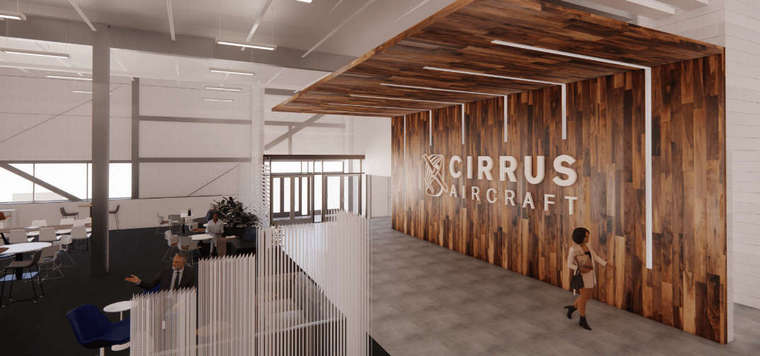
Cirrus Aircraft announced plans to develop the Duluth Innovation Centre at its headquarters following the recent acquisition of the former Northwest Airlines Corp. facility, more recently occupied by AAR Corp., located at the Duluth International Airport (KDLH) in Minnesota.
Cirrus Aircraft will invest heavily to transform the 189,000-square-foot building on 39 acres into a state-of-the-art Innovation Centre where engineers will develop the next generation of Cirrus aircraft. The Duluth Innovation Centre will feature amenities and flexible workspaces that enhance the working environment as people return to the office. Inspired interior features and design provide optimal collaborative workspace and break from the traditional office and lab environment.

“Doubling down with a massive facility such as this underscores our relentless pursuit of continuous innovation that makes owning and operating a Cirrus safe, convenient and easy,” said Zean Nielsen, Chief Executive Officer of Cirrus Aircraft. “We are a company of big ideas such as putting a parachute on every Cirrus aircraft, designing and building a single engine Jet, introducing Safe Return Autoland, rolling out Cirrus IQ connectivity and offering a 360-degree ecosystem around the customer. This investment solidifies Cirrus Aircraft's commitment to continuous innovation. We want talent to think of Cirrus Aircraft, Duluth, and now the new Innovation Centre as a special place where the latest and greatest general aviation technologies come to life. The Innovation Centre is designed to become the epicenter for personal aviation engineering and to attract top talent from around the world.”
“Duluth and Cirrus Aircraft have a long and important history of being great to and for one another and the site of the Innovation Centre is no different,” said Duluth Mayor Emily Larson. “For Cirrus Aircraft to expand their footprint in their hometown of Duluth means the world to us because it further elevates Duluth throughout the world of aviation. We are thrilled to support innovation while repurposing this asset. We are eager to decrease public liability while exponentially growing the aviation economy and we are one hundred percent committed to Cirrus Aircraft's vision as being central to our own vision of economic development within the City of Duluth.”

“From the founding days of Cirrus Aircraft in the basement of a Wisconsin barn to the new Innovation Centre, the company has maintained a rich culture of innovation that has changed personal aviation,” said Pat Waddick, President of Innovation and Operations of Cirrus Aircraft. “This investment in a world-class facility brings together our engineering, flight test, experimental, advanced design and developmentand other key Product Development areas. We are excited about how our investments in facilities, people and programs will lead to changing the world - again!”
On August 24, the Duluth Economic Development Authority (DEDA) approved the agreement authorising the sale of the former Northwest Airlines facility with a 60-year ground lease. The agreement releases the DEDA's ownership of the facility and the ongoing financial burden as the building has been without a tenant since May 2020, resulting in over 200 job cuts due to the pandemic. Moreover, the sale will save the city over $600,000 annually in maintenance, operating and tax expense.
Cirrus Aircraft aims to begin renovations by September 2022.

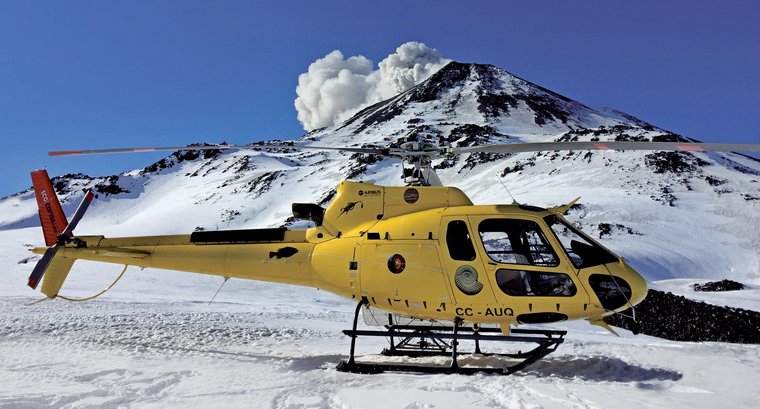
Ecocopter MoU signature
With this agreement, the partners will explore and define launch scenarios for air mobility operations, notably in Ecuador, Chile and Peru. This includes joint activities to develop UAM operations over the continent, as well as ways to target first use cases and pilot cities and regions. This partnership is an expansion of the manufacturer's strong relationship with Ecocopter, who operates a fleet primarily comprised of Airbus helicopters for aerial work missions in a variety of industrial sectors.
Marcelo Rajchman, Ecocopter's Corporate CEO, said: “With already 20 years of experience operating helicopters and 5 years' operating drones, this partnership is a natural step for us. We seek to be a relevant player in the UAM ecosystem and the projects we will develop together with Airbus will bring us closer to this goal.”

Balkiz Sarihan, Airbus' Head of Partnerships & Strategy Execution for UAM, added: “We are excited to extend our long standing relationship with Ecocopter. Together we are taking concrete steps in the co-creation of the UAM ecosystem and our decarbonisation roadmap. This partnership leverages Airbus' expertise in innovative vertical flight technologies, and Ecocopter's extensive operational history and innovative culture.”
Established in 2003, Ecocopter is a reference in highly complex aerial work missions in South America. Its fleet of Airbus helicopters, consisting of 16 H125s, two H135s, and three H145s, is characterised by their high versatility and perform missions ranging from offshore transport, mining support, medical evacuation, firefighting and almost the entire range of aerial work missions.
In September 2021, Airbus unveiled its eVTOL prototype CityAirbus NextGen, to explore advanced air mobility technologies and bring urban air mobility services to life. With an operational range of 80 km and a cruise speed of 120 km/h, it has been developed to be suited for a range of deployments in urban areas and beyond. The Company just announced the construction of a dedicated centre to test the aircraft's systems in the lead up to its maiden flight. Airbus is also working closely with industrial and institutional partners to lead the development of urban air mobility ecosystems, as recently announced with ITA Airways in Italy, or through the launch of the Air Mobility Initiative in Germany.

Bombardier is proud to announce that its newest business jet, the Challenger 3500 aircraft, has been honoured as the “Grand Winner” in the Industrial Design / Automotive & Transportation category at the 15th edition of the “Grands Prix du Design.” The international award recognises excellence in design and celebrates the talented professionals who inspire through their creative vision.
“I am delighted that the new Challenger 3500 aircraft has once again been recognised for its innovative and exceptional cabin design,” said Éric Martel, President and Chief Executive Officer, Bombardier. “Our talented team at Bombardier designed and crafted the industry-leading Challenger 3500 business jet for our discerning customers, offering them what they look for most in a business jet - an unprecedented cabin experience.”
Launched in 2021, the Challenger 3500 business jet is the industry's best super mid-size jet and the latest evolution of Bombardier's best-selling Challenger platform. The new Challenger 3500 aircraft introduces a redesigned cabin interior unlike any other in a medium-category business jet, combining intelligent and sustainable cabin features that offer the ultimate in comfort and function. The Challenger 3500 business jet includes Bombardier's exclusive and patented Nuage seat as part of the aircraft's standard configuration. Other new baseline features include the industry's first voice-controlled cabin to manage lighting, temperature and entertainment systems, the first wireless chargers available throughout the cabin, and the only 24-inch, 4K display in its class. In the cockpit, Bombardier introduced a standard-equipped auto throttle system to the Challenger 3500 flight deck.

As a further example of Bombardier's innovative spirit and its commitment to the environment, the next-generation Challenger 3500 aircraft was conceived through a sustainable lens. The Challenger 3500 aircraft is the first business jet in the super mid-size segment to have an Environmental Product Declaration (EPD), which discloses fully transparent environmental information about a product's life cycle, such as CO2 emissions, noise, water consumption and other key environmental impact indicators. In addition to the EPD, customers are given the option to choose from a selection of high-end sustainable materials for the cabin.

Boeing and its joint venture partner Wisk today released a roadmap for transitioning to a future where automated and uncrewed aircraft can safely carry passengers and cargo in urban and suburban areas. The concept of operations lays out the technology, regulatory and social recommendations needed to deploy Urban Air Mobility (UAM) in the United States and integrate it into the national airspace system.
“We're working to enable a future of aerospace that is safe, sustainable and at scale. Uncrewed operations will be fundamental to realising that vision and we have to exceed the current safety standards for the air transportation system,” said Brian Yutko, Boeing Vice President and Chief Engineer of Sustainability & Future Mobility.
The concept of operations begins by proposing bedrock principles for urban air mobility, including that flights should be safe and affordable for everyone. Additionally, the aircraft would be automated to reduce the load on air traffic controllers and pilots, and they would fly day or night under visual or instrument flight rules, and be supported by automated onboard and ground-based systems.

“The important work we're sharing today provides a stepping stone in the advancement of UAM in the U.S. and the world,” said Gary Gysin, CEO of Wisk, which has been working to bring to market the first all-electric, self-flying air taxi in the U.S.
“The vison we have outlined is the result of many years of collaboration with Boeing, the FAA, NASA and key industry stakeholders. As a result, this document offers the most comprehensive framework proposed to date with a vision for enabling UAM in the national airspace. Wisk is committed to deliver, with its partners, on this vision,” said Gysin.
Boeing and Wisk say that evolutionary and pragmatic methods will be needed to make the vision of UAM a reality. This includes the creation of new infrastructure such as 'vertiports,' locations where UAM aircraft can take off and land, load and unload passengers and receive services. Additionally, while the aircraft will be automated, Boeing and Wisk recommend the creation of 'fleet operations centres' where 'multi-vehicle supervisors' will monitor flights, implement air traffic control instructions to maintain aircraft separation, and ensure safe operation of the flight.

“The work we've done with our partners at Wisk demonstrates how this shared vision can become reality, and we're excited to share these ConOps with public, government, policy and regulatory stakeholders to engage across industry to shape that future,” said Yutko.

USA

On 4th September, 2022, at 15:09 Pacific daylight time, a de Havilland DHC-3, N725TH, was substantially damaged when it impacted Mutiny Bay near Freeland, Washington, and sank.
The pilot and 9 passengers were fatally injured. The airplane was operated as a Title 14 Code of Federal Regulations (CFR) Part 135 scheduled flight. The US Coast Guard and good Samaritans responded to the accident site.
The accident occurred during the pilot's second trip of the day; each trip involved multiple flight legs. A review of Federal Aviation Administration (FAA) tracking data revealed that the accident flight departed from Friday Harbour Seaplane Base (W33), Friday Harbour, Washington, about 14:50 with a destination of Renton Municipal Airport (RNT), Renton, Washington. The track data indicated the airplane flew a southerly heading before turning south-southeast. The en route altitude was between 650 and 975 ft above mean sea level (msl), and the groundspeed was between 115 and 125 knots. At 15:08:43 the altitude increased to 1,125 ft, and the groundspeed reduced to 109 knots. At 15:08:49, the altitude decreased to 875 ft and the groundspeed reduced to 100 knots. The tracking data ended at 15:08:51, at an altitude of 700 ft and groundspeed of 55 knots.
Witnesses near the accident site reported that the airplane was in level flight before it entered a slight climb, then pitched down in a near-vertical descent. The airplane continued in a noselow, near-vertical descent until it impacted the water in Mutiny Bay. Several witnesses described the airplane as “spinning,” “rotating,” or “spiralling” during portions of the steep descent.
One witness reported hearing the engine/propeller noise and noted that he did not hear any “pitch change” in the noise.

The pilot began working for the operator in 2013 and was one of two pilots who flew the DHC3, which he began flying in 2017. He had accrued a total of 4,686 flight hours as of 31st May, 2022. His total flight hours in the DHC-3 have not yet been determined. He received training in emergency drills and procedures in May 2022, and an aircraft competency check in June 2021.
The airplane's most recent 100-hour inspection was performed on 1st September, 2022. Included at that time were recurring inspections required by Airworthiness Directives (AD) 83-04-05 (control column lower assembly) and 2011-18-11 (elevator control tabs). A left-hand rudder retract cable was replaced during the 100-hour inspection. The previous 100-hr inspection was performed on August 16, 2022, which also included the recurring AD inspections noted above.
At that time, the horizontal stabilizer hinge bolts, a right-hand engine ignitor, and a left-hand float locker latch were replaced.
The airplane was not equipped nor was it required to be equipped with a flight data recorder or cockpit voice recorder. A King 560 Enhanced Ground Proximity Warning System was installed, which can retain some parametric flight data; however, the unit was not crash-protected. Some floating debris was recovered by local authorities and good Samaritans who responded to the accident site. This included three 6-ft sections of aluminium honeycomb panels used for flooring in the airplane, a seat cushion and seat belt, and small sections of foam, consistent with a modification made to the landing floats.

South Africa, OR Tambo International: A British Airways flight BA55, an Airbus A380-841, suffered a bird strike while on approach to Johannesburg-O.R. Tambo International Airport (JNB), South Africa. The aircraft was not able to carry out the return leg back to London-Heathrow Airport.
DRC, eastern DRC: Uganda People's Defence Force helicopter with seven on board was shot down by rebels in the Democratic Republic of the Congo. There were no survivors.

Italy, NW of Bolzano Airport: A BRM Aero Bristell TDO with two occupants suffered an engine failure. The pilot used the BRS airframe parachute and the aircraft came down in the parking lot of a supermarket located 500 meters north west of Bolzano Airport.
Germany, near Gera-Leumnitz Airfield: Two Zlín 526AFS Akrobat Special aircraft of Kunstflugstaffel Gera collided in mid-air near Gera-Leumnitz Airfield (EDAJ), Thuringia and crashed in a field. Both pilots, Dieter Geipel (73) and Michael Storeck (42), died and both aircraft were destroyed. Two Zlín 526AFS Akrobat Special aircraft of Kunstflugstaffel Gera collided in mid-air near Gera-Leumnitz Airfield (EDAJ), Thuringia and crashed in a field.Both pilots, Dieter Geipel (73) and Michael Storeck (42), died and both aircraft were destroyed.


23 SEPTEMBER 1941
Hans-Ulrich Rudel single-handedly sinks a Soviet battleship (the Marat) flying a Junkers Ju 87

The most decorated German pilot of the war and the only recipient of the Knight's Cross with Golden Oak Leaves, Swords, and Diamonds, Rudel was credited with the destruction of 519 tanks, one battleship, one cruiser, 70 landing craft and 150 artillery emplacements. He claimed 51 aerial victories and the destruction of more than 800 vehicles. He flew 2,530 ground-attack missions exclusively on the Eastern Front, usually flying the Junkers Ju 87 "Stuka" dive bomber.
Rudel died after suffering another stroke in Rosenheim on 18 December 1982 and was buried in Dornhausen on 22 December 1982.
Bonus Video
Extra Formation Flight to the SAC Nationals at Ladysmith
Google Banner Ad

 |
 |
 Copyright © 2024 Pilot's Post PTY Ltd
The information, views and opinions by the authors contributing to Pilot’s Post are not necessarily those of the editor or other writers at Pilot’s Post.
Copyright © 2024 Pilot's Post PTY Ltd
The information, views and opinions by the authors contributing to Pilot’s Post are not necessarily those of the editor or other writers at Pilot’s Post.